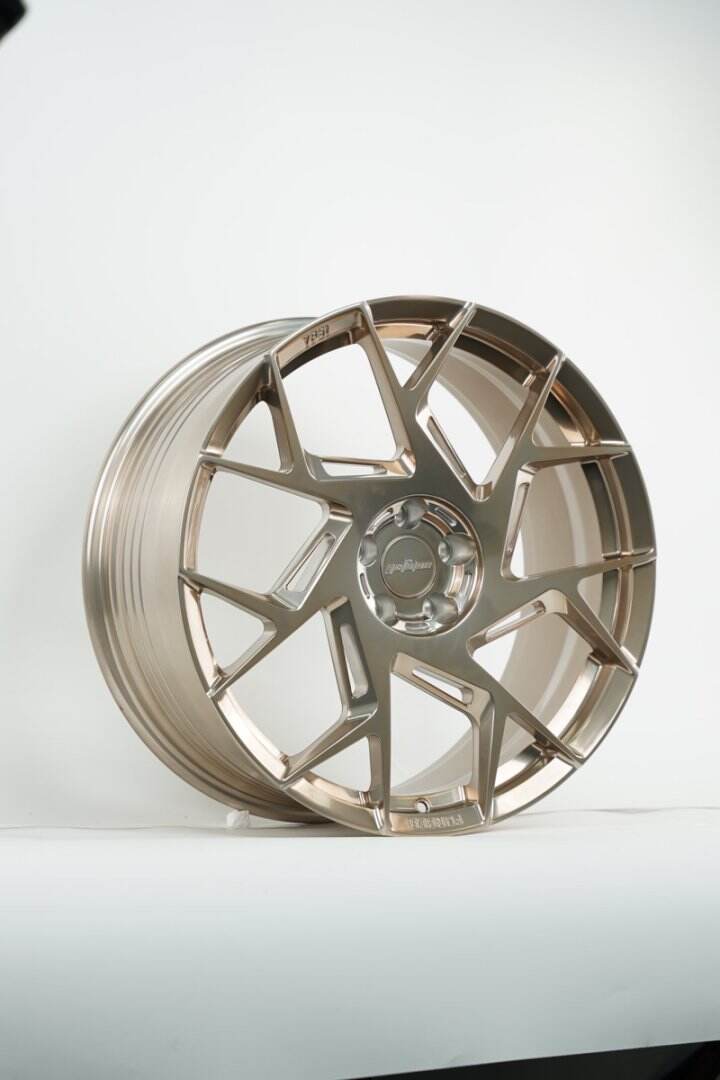Anatomy of 3-Piece Wheels: Construction Breakdown
Component Structure: Rim Halves & Center Disc Design
Building 3-piece wheels takes some serious craftsmanship, with careful choices made about what materials go where and how they fit together. Most often, the outer parts and middle section come from either regular aluminum or the stronger forged variety, striking a balance between being tough enough and not adding unnecessary bulk. Forged aluminum gets special attention in racing and performance setups because it just holds up better under stress. When designers get to work on these wheels, they rely heavily on CAD software to nail down every measurement that matters for both how well the wheel performs and whether it stays safe at speed. These digital tools let engineers create shapes that would be impossible by hand, ensuring the final product can handle all sorts of punishment without cracking or failing.
What really sets 3 piece wheels apart is how they break down into separate components, especially that center disc part. Compared to old school single piece designs, these wheels give owners way more flexibility when it comes to putting their own stamp on things. Want some bold colors? No problem. Looking to add personalized engraving work? That works too. The whole point is creating something that matches exactly what someone wants for their ride. But there's another angle here worth mentioning. When something gets damaged, instead of throwing away the whole wheel, folks just swap out the broken component. Makes sense right? Saves money in the long run and means these wheels tend to last much longer than standard models. For serious gearheads and track day regulars who care about both looks and practicality, this kind of setup often pays off big time.
Sealing Technology & Pressure Testing Methods
The sealing tech used in three piece wheels plays a big role in keeping air inside and shielding components from dirt, moisture and road grime. Most wheel makers go with either special sealant compounds or rubber gaskets between those inner and outer barrel sections to create an airtight fit. Getting this right matters because proper sealing keeps tire pressure stable over time and actually affects how efficiently the wheel cuts through air at speed. Some bolted designs though need closer attention since those fasteners can loosen up after repeated use. Mechanics often recommend checking these connections every few thousand miles just to be safe and avoid unexpected flat spots down the road.
When it comes to pressure testing, those 3 piece racing wheels get put through some serious hoops before anyone ever mounts them on a car. What happens? Well, manufacturers basically throw them into simulated race situations where they're forced to handle all sorts of stress without cracking or failing. The big names in this field, like the Society of Automotive Engineers or SAE for short, have set pretty strict rules about what constitutes acceptable performance. These guidelines look at everything from how long the wheel holds up over time to whether it can take sudden impacts without breaking apart. That's why most serious racers stick with 3 piece designs when speed matters most. And don't forget about those fancy seals inside either. Modern tech has made sure these components stay tight even when temperatures spike during races, which means drivers can focus on winning instead of worrying about their wheels falling apart mid-corner.
Key Advantages of 3-Piece Wheel Systems
Customization Flexibility for Offset & Width
Three piece wheels give drivers something pretty special when it comes to adjusting offset and width settings so they can fine tune how the wheels work with different cars. People love these wheels because of how they're built in three separate parts. Want bigger or smaller? No problem. Need different fitments? Just swap components around. The way these wheels are designed makes cars perform better on the road while still letting folks put their own stamp on the look. Car fans get to pick from tons of colors, finishes, and design touches that really make the wheels stand out according to what catches their eye. Take Liberty Walk as an example. They've been using three piece wheels in their custom jobs for years now, making sure everything looks good visually while still meeting all those important performance requirements too.
High-Performance Forging vs. Cast Construction
Looking at forged versus cast wheels shows pretty big differences when it comes to strength, weight, and how long they last. Forged wheels get made by applying massive pressure during production, creating something much denser and stronger than regular wheels. That makes them perfect for situations where things get really intense, like on race tracks. Cast wheels work differently though. They're basically just melted aluminum poured into molds, and sometimes this leaves little flaws that weaken the wheel over time. Most serious racing teams now go for those three piece forged setups because drivers notice faster laps and better cornering. Custom forged wheels in motorsports don't just hold up better when things get rough, they actually change how the whole car behaves on track. That's why these wheels dominate professional competitions across the board.
3-Piece vs. 2-Piece vs. Monoblock Wheels
Weight Comparison in Racing Applications
In racing circles, nobody disputes that wheel weight makes all the difference when it comes to how a car behaves on the track, particularly during acceleration phases and cornering. Monoblock wheels definitely cut down on mass because they're made from one solid piece, but what gives 3-piece wheels an edge is their modular setup. Teams can actually swap out parts made from different materials depending on what they need for a particular race weekend. The way 3-piece wheels separate the barrel from the center means manufacturers can shave off pounds while still keeping structural integrity intact. Most mechanics will tell anyone who asks that reducing unsprung weight improves both acceleration and handling characteristics. Look at Formula 1 teams specifically - they love these lightweight options even though building them takes extra time and effort. The payoff? Faster lap times and cars that respond quicker to driver inputs, which matters a lot when milliseconds decide championship outcomes.
Repairability & Modular Replacement Benefits
Three piece wheels have a real advantage when it comes to fixing them and saving money over time. Monoblock wheels usually need complete replacement if they get damaged at all, while 3 piece wheels let mechanics swap out just the broken part like the rim or center piece. This saves a ton on maintenance bills and keeps cars back on track faster after crashes or wear and tear. Racing teams love this setup because they can replace one component instead of paying for brand new wheels every season. Some F1 teams report cutting their wheel budget by nearly half thanks to this system. Mechanics tell stories about saving hundreds during pit stops simply by swapping parts rather than dealing with expensive whole wheel replacements.
Top Applications & Leading Brands
Track-Ready 3-Piece Racing Wheel Features
The right set of wheels can make all the difference on the track when talking about racing performance and staying safe. Most track ready 3 piece racing wheels come built light but strong enough to handle what happens during hard cornering and straight line speed. The lighter weight helps cars accelerate faster and turn better without sacrificing durability needed for rough track conditions. Many modern racing wheels incorporate special alloys that resist bending even after hours of racing where temperatures inside wheel wells can get extremely hot. Racing teams love quick release systems because they save precious seconds during pit stops. Tire changes happen in record time thanks to these mechanisms. At big races such as Le Mans or Daytona, teams using these types of wheels consistently beat competitors who stick with traditional setups. Their modular design means mechanics can tweak settings between sessions without swapping entire wheels, giving drivers an edge throughout long endurance races.
Best 3-Piece Wheel Brands for Custom Builds
When it comes to building custom cars, a few names consistently pop up when talking about great 3 piece wheels. Work Wheels has made quite a name for themselves over the years thanks to their focus on new tech stuff and really good build quality. Their wheels appeal to serious racers as well as weekend gearheads who want something that looks good and performs even better. Then there's Forgeline, a favorite among track day warriors because they forge their wheels from scratch. These bad boys are tough enough to handle punishment but light enough not to slow down performance. BBS Wheels remains a big deal too, sitting pretty at the top of many buyer lists and picking up hardware at various award shows across the industry. For anyone looking to upgrade their ride with proper 3 piece wheels, these companies represent some solid choices that won't disappoint.
Maintenance Essentials
Preventing Leaks in Multi-Piece Assemblies
Air leaks in multi piece wheel assemblies really hurt performance over time. The best way to stop this problem? Keep those seals intact with quality sealants and proper gaskets made specifically for three piece wheels. Don't forget regular checks either. Go ahead and tighten all those bolts while looking closely at how well the seals hold up. This kind of attention makes a big difference in how long the wheels last before needing replacement. Most mechanics recommend getting a professional look at them every couple of months too. We see plenty of cases where small issues like loose bolts or worn seals lead to bigger problems down the road. Stick with these basic maintenance steps and drivers will notice better handling and fewer unexpected breakdowns no matter what kind of driving conditions they face.
Anodized Finishes & Corrosion Prevention
Anodizing is pretty much essential for protecting against corrosion, especially where conditions get tough like near coasts or places exposed to chemicals regularly. The process creates a protective coating that makes wheels way more resistant to stuff that causes rust and degradation. Polishing on a regular basis keeps them looking good, but it actually does something important too for maintaining those protective qualities. Some research showed that wheels treated with anodization last about 30% longer than ones without this treatment. For anyone wanting their wheels to stay strong and attractive, setting up a basic cleaning routine makes all the difference. Wheels will keep performing well while still looking sharp even after years of use.




